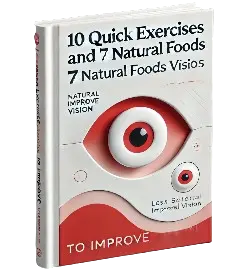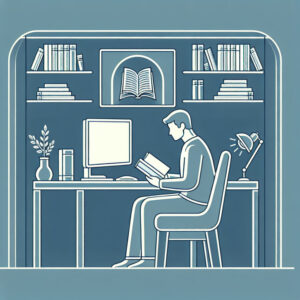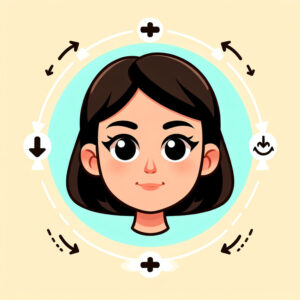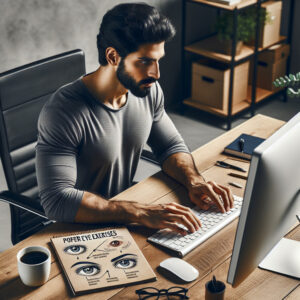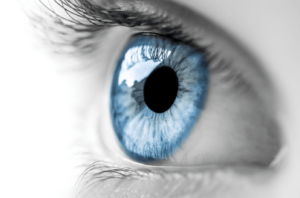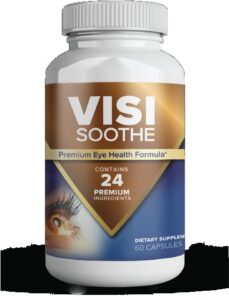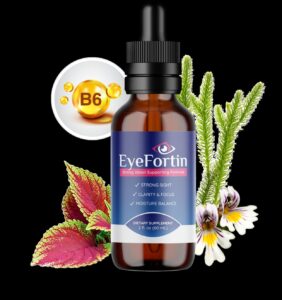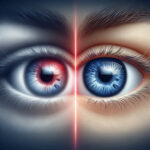How to Improve Near Eyesight Permanently: Long-Term Solutions for Clear Vision
How to Improve Near Eyesight Permanently: Long-Term Solutions for Clear Vision
Hey there! Let’s talk about something super important—your near vision. That’s your ability to see things up close, like when you’re reading a book or scrolling through your phone. As we get older, a lot of us start noticing our near vision isn’t what it used to be. But don’t worry, this guide is here to help you explore ways to improve it for good.
Understanding Near Vision Decline: What’s Really Going On?
Near vision decline often happens because of something called presbyopia—a fancy term for the natural aging process in your eyes. It makes focusing on close objects tougher than before. You might find yourself squinting more or holding books farther away to read them. Sound familiar? Yeah, that’s presbyopia doing its thing.
What causes it? Well, age is a big factor, but genetics, medical conditions like diabetes, and even your lifestyle (like staring at screens all day) can play a role too. It might feel frustrating, but the good news is there are plenty of ways to tackle it.
Lifestyle Changes That Can Make a Big Difference
Let’s start with what you eat. Your eyes need some serious nutrients to stay healthy, and guess what? You can get them from your food! Load up on foods rich in antioxidants, vitamins A and C, and zinc. Think carrots, leafy greens, citrus fruits, and nuts. Your eyes will thank you.
And don’t forget about exercise. Yep, working out isn’t just for your body—it’s good for your eyes too! Regular physical activity boosts blood flow to the eyes, keeping them healthy and happy.
Now, let’s talk screens. We all love our devices, but staring at them nonstop can take a toll on your vision. Try the 20-20-20 rule: every 20 minutes, look at something 20 feet away for 20 seconds. It’s like a mini vacation for your eyes and can help reduce strain.
Optical Solutions: Tailored to You
If lifestyle changes aren’t enough, don’t worry—there are some seriously cool optical solutions out there. Glasses and contacts are old favorites, but have you heard about progressive lenses? They’re like multifunctional glasses that adjust focus depending on what you’re looking at. Pretty neat, right?
Choosing the right eyewear isn’t just about fashion—it’s about what works best for your lifestyle. If you need clear vision both up close and far away, bifocals or progressive lenses might be your go-to. Your eye doctor can help you figure out what fits your needs best.
Surgical Options: A Game-Changer?
If you’re ready to consider something more permanent, surgeries like LASIK or PRK could be options. These procedures reshape the cornea to correct refractive errors, and they’re pretty low downtime compared to other surgeries. But before you jump in, make sure to chat with your eye doctor about whether it’s right for you.
It’s important to weigh the pros and cons—like any surgery, there are risks and recovery times to think about. Do your homework and ask lots of questions to feel confident in your decision.
Regular Eye Exams: The Unsung Heroes of Vision Health
Here’s a pro tip: regular eye exams aren’t just about updating your prescription. They’re crucial for catching any potential issues early on, which can save you a lot of hassle down the line. Plus, they help you stay on top of age-related changes in your vision.
Prepping for an exam is easy—just bring along your medical history and current eyewear (if you have it). Your eye doctor will take care of the rest, leaving you with a clearer picture of your vision health.
Eye Exercises: Do They Actually Work?
Okay, so can eye exercises help improve near vision? The short answer is they won’t reverse presbyopia, but they might help keep your eyes more flexible and focused. Think of them like a workout for your peepers.
Simple exercises like the pencil push-up (seriously, it’s as fun as it sounds) or focusing on different distances can make a difference when done consistently alongside other treatments. It’s all about finding what works best for you.
Long-Term Care: Protecting Your Vision
Protecting your eyes from the sun isn’t just about looking cool—it’s about keeping them healthy too. Sunglasses with UV protection are a must, especially when you’re outdoors for long stretches.
And let’s not forget about staying informed. New advancements in vision care pop up all the time, so it pays to keep an eye (pun totally intended) on what’s out there. The more you know, the better equipped you’ll be to take care of your vision as you age.
Conclusion: Your Roadmap to Better Vision
Improving near eyesight permanently is all about mixing and matching solutions that work for you—whether it’s lifestyle tweaks, optical aids, surgery, regular check-ups, or eye exercises. The key is consistency and being proactive about your vision health.
Your eyes are amazing, but they need some TLC to stay that way. By taking charge of your eye health today, you’re setting yourself up for clearer, more vibrant vision tomorrow. So go ahead—give your eyes the care they deserve. They’ll thank you for it!
Natural Remedies Revealed: How To Improve Near Eyesight Without Surgery
Understanding Near Eyesight: Why It Matters as You Age
Ever noticed how hard it gets to read small text as you age? That’s near eyesight. It’s your ability to see clearly at close distances—like reading a book or threading a needle. But as we get older, this ability can fade, making daily tasks tougher.
So why should you care about improving near vision? Well, poor vision can lead to frustration and even safety issues, like struggling to read medication labels. Common causes include presbyopia (age-related focusing difficulty) and eye strain from screens. The good news? You can take steps to enhance your eyesight naturally.
Let’s dive into how you can improve your near vision without surgery—through diet, exercises, lifestyle changes, and natural remedies.
Feeding Your Eyes: A Diet for Clear Vision
Your eyes need the right nutrients to stay sharp. Think of them like a car—they run best with premium fuel. Here’s what to include:
– **Leafy greens**: Spinach and kale pack lutein and zeaxanthin, which protect your eyes.
– **Fatty fish**: Salmon and tuna offer omega-3s crucial for eye structure.
– **Berries & citrus**: Rich in vitamin C, they help guard against damage.
– **Nuts & seeds**: Almonds and sunflower seeds provide vitamin E, another antioxidant.
Try this simple recipe: a spinach and salmon salad with cherry tomatoes and sunflower seeds. Drizzle with olive oil and balsamic vinegar for a tasty treat that’s great for your eyes.
Eye Exercises: Fun Ways to Sharpen Your Vision
Just like your body needs exercise, so do your eyes! These quick tips can make a big difference:
– **The 20-20-20 rule**: Every 20 minutes while on screens, focus on something 20 feet away for 20 seconds. It’s easy and effective.
– **Pencil push-up**: Hold a pencil at arm’s length, slowly bring it closer until blurry, then move back out. Repeat daily—it works!
Consistency is key. Regular practice can yield long-term benefits.
Lifestyle Adjustments for Better Vision
Your habits play a big role in eye health. Here are some tweaks:
– **Limit screen time**: Use blue-light glasses or filters to cut strain.
– **Ergonomic workspace**: Position your monitor at eye level with good lighting and posture to reduce neck tension.
– **Rest & relax**: Your eyes need downtime. Sleep well and take breaks throughout the day.
These changes can protect and improve your vision over time.
Natural Remedies: More Ways to Support Eye Health
Looking for extra help? Try these natural options:
– **Herbs like bilberry and ginkgo**: May boost night vision and blood flow.
– **Acupuncture & yoga**: Can enhance circulation and reduce eye tension.
Start slowly, and consult a healthcare pro before adding new supplements or therapies.
Dispelling Myths About Near Vision Improvement
Let’s tackle some common myths:
– **Can you reverse poor near vision?** While natural methods won’t restore youthful vision overnight, they can slow decline and improve it with effort.
– **Quick fixes?** No magic pills here. Improvement takes time, patience, and a holistic approach.
Remember, your eyes are complex—changes take time. Focus on long-term investment in eye health.
Expert Tips for Long-Term Eye Health
Maintaining near vision needs care:
– **Track progress**: Keep a journal of exercises, diet, and adjustments to see what works.
– **Seek help when needed**: If you notice sudden changes or severe pain, consult a professional.
– **Stay consistent**: Even small efforts daily add up over time.
Conclusion: Take Charge of Your Near Vision
In this guide, we’ve explored ways to improve near eyesight naturally. By focusing on diet, exercises, lifestyle, and natural remedies, you can enhance your eye health.
Improving near vision is a journey needing patience and commitment. Celebrate small wins—every step counts towards better long-term eye health.
So, start today! Small changes now lead to big rewards later. Your eyes will thank you!
Supplements and Diet: Enhancing Your How to Improve Near Eyesight Journey
Understanding Near Eyesight: What You Need to Know
Ever noticed how your reading gets a bit fuzzy as you hit your 40s? That’s presbyopia, a common age-related condition where focusing on close-up tasks like reading or screens becomes tougher. It’s like your eyes are having a mini-retirement, but don’t worry—it doesn’t mean you have to give up crafting or cooking.
Good near eyesight isn’t just about seeing clearly; it’s about living fully. Whether you’re reading a recipe, sending an email, or working on a craft project, your vision plays a crucial role in daily life and productivity. Taking care of your eyes now can save you from the headaches (literally) later.
Food for Your Eyes: What You Eat Matters
Your diet isn’t just about how you look; it’s about how well you see. Eating right can be a game-changer for your eye health, protecting against issues like cataracts and macular degeneration. Think of it as fueling up with the best ingredients.
So, what should you be munching on? Leafy greens are packed with lutein—think of them as your vision superheroes. Citrus fruits bring in vitamin C, and nuts offer healthy fats that keep things running smoothly. A simple salad with spinach, oranges, and almonds is like a power meal for your eyes.
Key Nutrients: Your Vision’s Best Friends
Vitamin A is the night vision hero, found in carrots and sweet potatoes, keeping your cornea and retina in tip-top shape. Vitamins C and E are antioxidants, like your eye’s personal bodyguards against oxidative stress from UV rays and pollution.
Zinc helps keep your retinas healthy, acting as a security guard by producing melanin to protect your eyes. Lutein and zeaxanthin, found in eggs and greens, filter out harmful blue light, giving your eyes some much-needed downtime.
Supplements: Your Vision’s Backup Team
If you’re not getting enough nutrients from your diet, supplements can step in as your backup squad. Options like multivitamins tailored for eye health, omega-3s for retinal function, and lutein/zeaxanthin are great choices. But remember, more isn’t always better—balance is key to avoid any unwanted side effects.
Hydration & Protection: Keeping Your Eyes Happy
Your eyes need water just like the rest of you. Staying hydrated keeps them moist and prevents dryness, especially when you’re glued to screens or in air-conditioned spaces. So, keep that water bottle handy!
Protecting your peepers from UV rays is a must. Sunglasses or hats can do the trick, shielding your eyes from harmful rays linked to cataracts. And don’t forget about work-life balance—give your eyes regular breaks with the 20-20-20 rule: every 20 minutes, check something 20 feet away for 20 seconds.
Tracking Your Vision Journey
Keep an eye on how things are changing. Notice any improvements or lingering issues? If diet alone isn’t cutting it, it’s time to call in the pros. An eye care expert can offer personalized tips, whether adjusting supplements or suggesting corrective measures.
Wrap Up: Seeing Clearly for Years to Come
Taking care of your eyes is a mix of good eats, smart choices, and regular check-ins. With consistent effort, you’re looking at a future with clearer vision and fewer headaches. Remember, it’s not just about what you eat—it’s about how you live.
So, keep eating those veggies, stay hydrated, and don’t forget your sunglasses. Your eyes will thank you for it!
How to Improve Near Eyesight for Computer Users: Reducing Eye Strain and Fatigue
To address your concerns about eye strain and improve your near eyesight, here’s a structured approach based on the thought process:
1. **Ergonomic Setup:**
– Adjust your computer monitor to be 20-25 inches away from your eyes and slightly below eye level.
– Position your chair so that your hips are level with your knees and ensure proper lower back support.
2. **Lighting Adjustments:**
– Minimize harsh overhead lighting by using softer alternatives or adjusting the angle of lights to reduce glare.
– Position your monitor perpendicular to windows to avoid direct sunlight causing reflections.
3. **Eye Strain Reduction Techniques:**
– Implement the 20-20-20 rule: Every 20 minutes, look at something 20 feet away for 20 seconds.
– Use apps or browser extensions like “Eyeleo” or “Break Timer” to remind you to take breaks.
4. **Diet and Hydration:**
– Incorporate foods rich in omega-3s (salmon, walnuts) and antioxidants (spinach, carrots) into your diet.
– Stay hydrated throughout the day and consider using artificial tears if needed.
5. **Blue Light Mitigation:**
– Invest in blue light glasses or apply anti-blue light filters to your screens.
– Adjust screen settings to reduce brightness and enable night mode for warmer tones.
6. **Regular Eye Care:**
– Schedule regular eye exams with an optometrist to address any underlying issues and receive personalized recommendations.
7. **Mindful Work Habits:**
– Alternate tasks requiring close focus with less visually demanding activities.
– Use apps like “Focus@Will” or “RescueTime” to monitor screen time and enforce breaks.
By systematically applying these strategies, you can create a healthier work environment that reduces eye strain and promotes better vision. Remember, small consistent changes can lead to significant improvements over time.
Natural Ways to Improve Your Near Eyesight
Understanding Near Eyesight: What You Need to Know
Ever noticed how your eyes seem to struggle when you’re trying to read or use your phone? That’s near eyesight—or near vision—in action. It’s all about seeing things clearly up close, whether you’re reading a book, threading a needle, or scrolling through social media. Now, while it’s totally normal for near vision to fade with age, there are plenty of natural ways to keep those close-up details sharp.
Why does near vision sometimes take a hit? Well, presbyopia (that age-related blur when focusing on close stuff) is one culprit. Then there’s digital eye strain from staring at screens all day, and let’s not forget about poor lighting making things worse. But here’s the good news: improving your near vision can make life easier and more enjoyable—no magnifying glass required!
How to Boost Near Vision Naturally: What You Eat Matters
Your eyes are hungry for nutrients, and guess what? Your diet is their best foodie friend. Start with Vitamin A-rich foods like carrots and spinach—they’re like armor for your cornea. Add in some Vitamin C and E from citrus fruits or nuts to keep oxidative stress at bay. Think of it as a tasty way to fight off the eye疲劳 monster.
Omega-3s are next on the menu, starring in fish like salmon or flaxseeds. They’re not just for fish sticks; these little powerhouses help keep your eyes moist and reduce dryness. So, whether it’s a salmon fillet or a sprinkle of flaxseed, you’re doing your eyes a solid. And hey, if you’re into smoothies, why not toss in some chia seeds for an extra boost? Your eyes will thank you!
Simple Tweaks to Supercharge Your Near Vision
Digital devices—love ’em or leave ’em, they’re part of our daily grind. But all that screen time can take a toll on your peepers. Enter the world of digital eye strain relief! Start by tweaking your device settings for optimal brightness and throw on a blue-light filter to keep things balanced. It’s like giving your eyes a much-needed vacation from the harsh glow.
And here’s a tip that’s as easy as 1-2-3: take regular breaks with the 20-20-20 rule. Every 20 minutes, look at something 20 feet away for 20 seconds. It’s like a mini reset button for your eyes. Plus, staying hydrated isn’t just for quenching your thirst—it keeps those peepers moist and comfortable. And don’t forget to move your body! Whether it’s yoga or a brisk walk, getting active boosts blood flow to your eyes, keeping them happy and healthy.
Eye Exercises That Actually Work
Let’s talk about eye exercises that pack a punch without feeling like a chore. Palming is a great one—just cover your closed eyes with your palms for a few minutes. It’s a simple way to relax and recharge those vision muscles. And here’s a fun one: focus on something far away, then switch to something close up. Alternate between the two, and voilà—you’re giving your eyes a workout without even breaking a sweat!
Natural Remedies That Could Make a Difference
Herbal supplements like bilberry and lutein are all-stars when it comes to eye health. They’re like the unsung heroes of your vision journey, fighting off oxidative stress and keeping things running smoothly. Essential oils such as frankincense might also help reduce eye strain, but be cautious and do your homework before diving in.
And then there’s acupuncture—a unique approach that some folks swear by for addressing underlying imbalances. It’s not for everyone, but it’s worth looking into if you’re curious about alternative options. Just remember to always consult a pro before starting anything new!
Protecting Your Vision for the Long Haul
Regular eye exams are your best bet for catching any issues early on. Think of them as check-ups for your eyes—better safe than sorry! Proper lighting is another key player in keeping eye fatigue at bay. Make sure your workspace is well-lit without that harsh glare, and position your computer at eye level. It’s all about creating a setup that works with you, not against you.
Real-Life Success Stories: Proof It Works
Want some inspiration? Meet the folks who’ve nailed near vision improvement naturally! One person tackled age-related loss head-on with diet and exercises, while another slashed digital strain by making smart lifestyle swaps. Their journeys show that patience and persistence pay off—so don’t give up hope!
Busting Myths About Near Vision Improvement
Let’s clear the air about some common myths. Sure, glasses are a thing, but natural methods can absolutely make a difference. Eye drops aren’t always the answer—digging into root causes is where it’s at. And over-the-counter supplements? They might not be one-size-fits-all, so personalized advice is key. No need to buy into the hype!
Wrap-Up: Take Charge of Your Vision
Improving near vision naturally is all about diet, lifestyle tweaks, exercises, and protecting your eyes. It’s a journey that requires patience and commitment, but trust us—it’s totally worth it. So, roll up your sleeves, dive into those healthy habits, and get ready to see the world in sharper focus!
How to Improve Near Eyesight: A Comprehensive Guide for Everyone
Understanding Near Eyesight: What You Need to Know
What is Near Eyesight?
Near eyesight, or near vision, is all about how clearly you can see things up close. Think of it like this: whether you’re diving into a good book, typing away on your computer, or trying to thread a needle, that’s when your near vision kicks in. It’s something we take for granted until it starts to fade.
As time goes on, many of us notice our near vision isn’t what it used to be—a condition called presbyopia. It’s like your eye’s lens gets a bit stiffer over the years, making it harder to focus on close-up stuff. And hey, even younger folks can have issues with near vision. Poor lighting, staring at screens all day, or underlying health problems can throw off your focus.
Common Issues with Near Vision
Fuzzy vision when looking at things up close is a biggie. You might find yourself squinting at your phone or pushing a book farther away to read it. It’s frustrating, and if you don’t do something about it, it can lead to eye strain.
Digital eye strain is another culprit—thanks to all the hours we spend staring at screens. Blurred vision, trouble focusing, and achey eyes are common symptoms. If you’re glued to your computer or phone, you probably know this feeling all too well.
Presbyopia, as mentioned earlier, is a natural part of aging that creeps up around age 40. It makes close-up tasks tougher, even if they were once second nature. It’s normal, but it can still throw a wrench in your daily life.
Why Improving Near Eyesight Matters
Your near vision is key for so many things—reading, cooking, crafting, you name it. Without it, simple tasks feel like a hurdle. Imagine trying to read the instructions for your favorite recipe and struggling to see the words. It’s not fun.
Clear near vision also plays a role in your overall well-being. Think about reading medication labels—having trouble there could lead to mistakes. Or even though it’s more about distance vision, good eyesight when driving keeps you safe on the road. The point is, clear vision matters everywhere.
And here’s the kicker: catching near vision issues early can save you from bigger problems down the line. Regular eye exams are your best bet for spotting any red flags before they become major headaches. Taking care of your eyes now means better comfort and peace of mind later on.
Correct and Strengthen Your Near Vision Over Time
Understanding How to Improve Near Eyesight: A Comprehensive Guide
Near vision is something we rely on every day—whether it’s reading a book, sending a text, or even threading a needle. But as we age, many of us notice that our ability to see clearly up close starts to fade. This can be frustrating and even limiting in daily life. The good news? There are steps you can take to improve your near eyesight over time. In this guide, we’ll walk you through everything you need to know about enhancing your vision health.
What is Near Vision?
Near vision refers to our ability to see objects clearly at a close distance—typically within 18 inches of our eyes. This type of vision is crucial for tasks like reading, writing, and using digital devices. The eye’s natural lens plays a significant role in focusing light to create sharp images for near vision. However, as we age, the lens becomes less flexible, making it harder to focus on close-up objects—a condition known as presbyopia.
The Importance of Near Vision for Daily Activities
Think about how often you use your near vision in a single day. From reading recipes while cooking to checking your phone notifications, your ability to see clearly up close impacts almost every aspect of life. Without proper near vision, even simple tasks can become challenging or tiring. This is why maintaining and improving your near eyesight is so important for overall quality of life.
Common Issues That Affect Near Vision
Several factors can affect your near vision:
- Presbyopia: Age-related loss of flexibility in the eye’s lens, making it harder to focus on close objects.
- Hyperopia: Farsightedness, which makes seeing up close more difficult than seeing at a distance.
- Cataracts: Clouding of the eye’s natural lens, which can blur vision at any distance.
- Digital Eye Strain: Prolonged screen use can lead to fatigue and difficulty focusing on close-up tasks.
Understanding these issues is the first step toward finding effective solutions to improve your near eyesight.
How to Improve Near Eyesight Through Lifestyle Adjustments
Diet and Nutrition for Eye Health
Your diet plays a significant role in maintaining healthy vision. Incorporating certain nutrients into your meals can help protect your eyes and even improve near vision over time. Key nutrients include:
- Vitamin A: Found in carrots, sweet potatoes, and spinach, it supports the health of your cornea and retina.
- Vitamins C and E: These antioxidants help protect your eyes from oxidative stress. Citrus fruits, bell peppers, and nuts are great sources.
- Zeaxanthin and Lutein: These compounds can reduce the risk of age-related eye conditions like macular degeneration. They’re found in leafy greens and eggs.
Making these foods a regular part of your diet is an easy way to support better near vision.
Staying Hydrated for Optimal Eye Function
Dehydration can lead to dry eyes, which may make it harder to focus on close-up tasks. Drinking plenty of water throughout the day helps keep your eyes moist and functioning properly. If you spend a lot of time in front of screens, consider using artificial tears or adjusting your workspace’s humidity levels to combat dryness.
Ergonomics: Setting Up Your Workstation Correctly
If you work at a computer or use digital devices frequently, proper ergonomics can make a big difference for your near vision. Position your screen about 20-25 inches away from your eyes and slightly below eye level to reduce strain. Use a document holder to keep reading materials at the same height as your screen. Good lighting is also essential—avoid glare by positioning your screen away from direct light sources.
Incorporating Regular Breaks into Your Routine
Extended periods of focusing on close-up tasks can lead to eye fatigue and strain. To prevent this, follow the 20-20-20 rule: every 20 minutes, take a break for 20 seconds and look at something 20 feet away. This simple habit can help reduce strain and improve your ability to focus over time.
Exploring the Role of Vitamin Supplements in Improving Near Vision
Key Vitamins and Minerals That Support Eye Health
If you’re not getting all the necessary nutrients from your diet, supplements can be a helpful addition. Look for formulas that include:
- Vitamin A: For maintaining healthy corneas and retinas.
- Zinc: This mineral helps transport vitamin A to the eyes and supports overall eye health.
- Lutein and Zeaxanthin: These antioxidants protect your eyes from harmful blue light and support sharp vision.
Always choose high-quality supplements and consult with a healthcare professional before starting any new regimen.
The Importance of Consulting a Healthcare Professional
While supplements can be beneficial, they’re not a one-size-fits-all solution. A healthcare provider can help you determine which vitamins or minerals you might need based on your individual health and dietary habits. They can also advise you on how to use these supplements safely and effectively.
Effective Exercises to Strengthen Your Near Vision
Understanding the Benefits of Eye Exercises
Eye exercises are a simple, effective way to improve focus and clarity for near vision. These exercises work by strengthening the muscles around your eyes and improving their ability to adjust focus. Over time, consistent practice can lead to better near vision and reduced strain during close-up tasks.
Simple Techniques to Improve Focus and Clarity
Try these easy eye exercises:
- Focusing Drills: Hold a small object like a pen at arm’s length. Focus on it clearly, then slowly bring it closer until your vision starts to blur. Repeat this several times daily.
- Eye Rolling: Roll your eyes in both clockwise and counterclockwise directions for 30 seconds each way. This can help improve flexibility and reduce strain.
- Palming: Rub your palms together to create warmth, then place them over your closed eyes. Relax in this position for a few minutes to soothe tired eyes.
Incorporate these exercises into your daily routine for best results.
Protecting Your Eyes from Strain and Fatigue
Reducing Digital Eye Strain: Tips for Screen Users
If you spend a lot of time in front of screens, take steps to reduce eye strain:
- Use blue light filters or glasses with anti-blue light coatings.
- Increase the text size on your devices to make it easier to read without squinting.
- Adjust your screen brightness to match the lighting in your environment.
Taking these steps can help protect your near vision from the effects of prolonged screen use.
Proper Lighting for Reading and Close-Up Tasks
Poor lighting can contribute to eye strain when doing close-up work. Use a well-positioned lamp or overhead light that provides consistent, glare-free illumination. Avoid reading in dimly lit areas, as this forces your eyes to work harder to focus.
How to Improve Near Eyesight with Professional Help
When to Consult an Eye Care Specialist
If you’re experiencing persistent difficulty seeing up close or notice sudden changes in your vision, it’s important to consult an eye care professional. They can diagnose any underlying issues and recommend appropriate treatments, such as corrective lenses or surgery.
Understanding the Options for Corrective Lenses or Surgery
If lifestyle adjustments and exercises aren’t enough to improve your near eyesight, there are several professional solutions available:
- Reading Glasses: These can provide temporary correction for presbyopia.
- Bifocal or Progressive Lenses: These glasses offer multiple focal points for seeing both near and far objects clearly.
- Refractive Surgery: Procedures like LASIK or lens replacement surgery can correct refractive errors and improve near vision in some cases.
Your eye care specialist will help you determine which option is best for your needs.
Monitoring Progress Through Regular Eye Exams
Regular eye exams are essential for maintaining healthy vision. They allow your eye care provider to detect any changes or issues early, ensuring that you receive timely treatment and advice on how to improve your near eyesight further.
Conclusion: Taking Charge of Your Vision Health
Improving your near eyesight doesn’t have to be complicated. By making simple lifestyle adjustments, incorporating eye exercises, and seeking professional help when needed, you can enjoy sharper, more comfortable vision for years to come. Remember to stay consistent with these strategies and schedule regular check-ups with your eye care provider to monitor your progress.
Your vision health is in your hands—take charge today!
Top Reading Glasses and Lenses: How to Improve Near Eyesight Instantly
Introduction: Understanding the Importance of Near Eyesight
Let’s face it—clear near vision is something most of us take for granted until it starts to fade. Whether you’re reading a book, scrolling through your phone, or working on a craft project, sharp close-up vision plays a huge role in our daily lives. Imagine struggling to read the words on a page or fumbling with small objects because everything up close looks blurry. It’s not just inconvenient; it can also affect your confidence and independence.
Why Clear Close-Up Vision is Crucial for Everyday Tasks
Clear near vision matters more than you might realize. From reading recipes to replying to texts, even the most mundane tasks become a hassle when your close-up vision isn’t sharp. Think about it: how many times have you squinted at a menu or held a book arm’s length away just to make out the words? Blurry near vision can lead to eye strain, headaches, and even accidents if you’re not seeing clearly while doing something like threading a needle or pouring a drink.
Common Causes of Blurry or Fuzzy Near Vision
While blurry close-up vision often comes with age, it’s not a done deal. Conditions like presbyopia—where your eyes lose the ability to focus on close objects—are usually the culprit. Other factors can also contribute, such as eye strain from staring at screens all day, poor lighting conditions, or underlying health issues like diabetes. The good news? Addressing these problems early can prevent them from getting worse and impacting your quality of life.
How Reading Glasses and Lenses Can Make a World of Difference
This is where reading glasses come into the picture (no pun intended). These simple yet effective solutions can instantly improve your near eyesight, allowing you to enjoy everyday activities without frustration or discomfort. Whether you’re someone who’s just starting to notice changes in their vision or you’ve been dealing with blurry close-up sight for a while, there are options available to suit every need and lifestyle.
What Are Reading Glasses and Lenses?
Exploring Different Types of Reading Glasses
Reading glasses aren’t a one-size-fits-all solution. There are various types designed to meet different needs. For example, some people prefer the convenience of ready-made reading glasses with fixed lens strengths, while others opt for custom prescription glasses tailored to their specific vision requirements. Plus, you can even find stylish options that double as fashion accessories—so no need to sacrifice style for functionality!
Understanding Lens Options: Single-Vision vs. Multi-Focal Lenses
When it comes to lenses, there are two main categories: single-vision and multi-focal. Single-vision lenses provide uniform magnification across the entire lens, making them ideal for those whose primary concern is seeing up close. On the other hand, multi-focal lenses offer multiple focal points, allowing you to see clearly at different distances without switching between glasses. This can be especially beneficial for individuals who need assistance with both near and intermediate vision tasks.
How These Solutions Enhance Near Eyesight Instantly
The beauty of reading glasses is that they provide immediate results. As soon as you put them on, you should notice a significant improvement in your ability to see clearly up close. This instant clarity can be transformative, making tasks like reading or working on crafts much more enjoyable and less stressful on your eyes.
Step-by-Step Guide to Choosing the Right Reading Glasses or Lenses
Assessing Your Vision Needs: When to Use Reading Aids
The first step in choosing the right reading glasses is understanding your vision needs. If you’re experiencing difficulty focusing on close objects, it’s a good indication that you could benefit from reading aids. Start by evaluating how often you struggle with near vision tasks and whether this is impacting your daily life. This self-assessment will help guide you toward the most suitable solution.
Finding the Perfect Fit: Frame Styles and Lens Strengths
Once you’ve determined that reading glasses are right for you, it’s time to consider frame styles and lens strengths. Experiment with different frame shapes and sizes to find a pair that feels comfortable and suits your face. When it comes to lens strength, don’t guess—use an eye chart or consult a professional to determine the appropriate magnification level. The goal is to achieve clear vision without strain.
Key Features to Look for in High-Quality Reading Glasses
Quality matters when it comes to reading glasses. Look for features like UV protection, anti-glare coatings, and scratch-resistant lenses to ensure durability and optimal performance. Additionally, consider lightweight materials that make the glasses more comfortable to wear for extended periods. Investing in a pair of well-made reading glasses will not only improve your vision but also enhance your overall experience.
Expert Tips for Maximizing Near Eyesight Improvement
How to Properly Use Reading Glasses for Optimal Results
To get the most out of your reading glasses, it’s essential to use them correctly. Start by positioning the glasses properly on your face and adjusting them as needed for optimal alignment with your eyes. Avoid over-reliance on squinting or leaning in closer, which can lead to eye strain. Take breaks periodically to give your eyes a rest, especially if you’re engaging in prolonged close-up tasks.
Maintaining and Caring for Your Reading Lenses
Proper care is key to extending the life of your reading glasses. Clean them regularly with a soft cloth or lens cleaner to remove smudges and dirt. Avoid using harsh chemicals or abrasive materials, as these can scratch the lenses. Store your glasses in a protective case when not in use to prevent damage. With good maintenance, your reading glasses will continue to serve you well for years to come.
When to Consider Upgrading to Prescription Glasses or Contacts
While reading glasses are an excellent solution for many people, there may come a time when upgrading to prescription glasses or contacts is worth considering. If your vision needs change significantly or if you’re dealing with other eye conditions, consulting with an eye care professional can help determine the best course of action. They can provide personalized recommendations tailored to your specific situation.
Alternatives to Reading Glasses: Exploring Other Options
Contact Lenses for Near Vision Correction
If you’re looking for an alternative to reading glasses, contact lenses might be a viable option. Designed specifically for near vision correction, these lenses can offer the convenience of clear vision without the need for frames. However, they do require proper care and maintenance to avoid complications. It’s important to discuss this option with your eye doctor to ensure it aligns with your lifestyle and vision needs.
Surgical Solutions Like LASIK or Lens Replacement Surgery
For those seeking a more permanent solution, surgical options like LASIK or lens replacement surgery are worth exploring. These procedures can correct near vision issues at their source, providing long-term clarity and reducing dependence on glasses or contacts. As with any surgery, it’s crucial to weigh the benefits and risks carefully and consult with a qualified ophthalmologist.
How These Alternatives Compare to Reading Aids
When comparing reading glasses to alternatives like contact lenses or surgery, it ultimately comes down to personal preference and specific vision requirements. Reading glasses offer an affordable, non-invasive solution that can be easily adjusted as needed. On the other hand, contacts or surgical options may provide more freedom but come with higher costs and potential risks. Consider discussing all your options with a professional to make an informed decision.
Conclusion: Empowering Your Daily Life with Clearer Vision
Recap of Key Takeaways: Choosing the Best Solution for You
In summary, improving your near eyesight doesn’t have to be complicated. Reading glasses and lenses provide an effective and accessible solution that can instantly enhance your vision clarity. By understanding your needs, exploring different options, and taking proper care of your chosen solution, you can enjoy clearer near vision and a more fulfilling daily life.
Final Thoughts on Maintaining Healthy Eyesight
Remember, maintaining healthy eyesight is an ongoing process. Regular eye exams are essential for monitoring changes in your vision and addressing any issues early on. Additionally, adopting good habits like taking breaks during screen time, eating a balanced diet rich in eye-healthy nutrients, and protecting your eyes from harmful UV rays can contribute to long-term ocular health.
How to Get Started with Improving Your Near Vision Today
If you’re ready to take the first step toward clearer near vision, start by assessing your current needs and researching the available options. Whether it’s purchasing a pair of reading glasses or scheduling a consultation with an eye care professional, there are plenty of resources to help you make informed decisions. Don’t let blurry near vision hold you back—take action today and enjoy the benefits of sharper, more confident vision!
Discover the Best Methods on How to Improve Near Eyesight
Understanding Near Eyesight: What You Need to Know
Near eyesight is something we use every day without even thinking about it. Whether you’re reading a book, typing on your computer, or doing some intricate work with your hands, good near vision makes all these tasks easier and more enjoyable.
What is Near Eyesight?
Near eyesight is your ability to focus on objects that are right in front of you—like when you’re reading or working on a craft project. It’s all about seeing the details clearly, which happens because of a process called accommodation.
Common Issues Affecting Near Vision
As we get older, our eyes naturally lose some of their ability to focus up close. This is why many people over 40 start noticing it’s harder to read small print or do detailed work without squinting or needing more light. Other common issues that can affect near vision include:
- Presbyopia: The natural aging of the eye, making close-up focusing tougher.
- Myopia (Nearsightedness): While usually linked to distance vision, it can sometimes make seeing up close harder if not corrected properly.
- Astigmatism: This causes blurry or distorted vision at all distances, including when you’re looking at something right in front of you.
Risk Factors for Poor Near Vision
Some factors can make it more likely that you’ll have trouble with near eyesight. These include:
- Age: The older we get, the more common presbyopia becomes.
- Heredity: If your family has a history of eye conditions, you might be at higher risk too.
- Health Conditions: Issues like diabetes or high blood pressure can impact eye health over time.
Understanding these factors is the first step toward taking charge of your near vision. Next, let’s look into simple methods you can use to improve it.
How to Improve Near Eyesight Through Eye Exercises
Eye exercises are a great way to keep your eyes in shape and maintain good near vision. While they won’t fix everything, they can help slow down age-related changes and keep your eyes healthy.
Simple Eye Exercises for Better Focus
Here are some easy exercises you can try at home:
1. The Pencil Push-Up Exercise
Hold a pencil at arm’s length and focus on the tip. Slowly bring it closer until your vision starts to blur, then move it back. Repeat this 5-10 times daily.
2. The Near-Far Focus Exercise
Pick an object about 10 feet away and another at arm’s length. Alternate focusing between them for 5-10 minutes twice a day.
The Role of Accommodation in Near Vision
Accommodation is the process your eyes use to switch focus from distant to near objects. As we age, this process becomes less efficient, making it harder to see things up close. Eye exercises can help maintain flexibility and improve focusing ability.
Frequency and Consistency in Practicing Exercises
Like any exercise, consistency matters. Aim for 2-3 sessions a day, each lasting about 5 minutes. Over time, you’ll likely notice improvements in your near vision and reduced eye strain.
While exercises can be beneficial, they aren’t the only factor influencing near eyesight. Diet also plays a significant role, as we’ll explore next.
Understanding Near Eyesight: What You Need to Know
Near eyesight is something most of us rely on without giving it much thought—until it starts to fade. Whether you’re reading a book, typing on your computer, or tying your shoes, clear near vision makes life easier and more enjoyable. But what exactly defines good near eyesight? And why do so many people experience challenges with this as they get older?
What is Near Eyesight?
Near eyesight is your ability to focus on objects within arm’s reach, usually about 12-14 inches away. This type of vision is crucial for tasks like reading, writing, and using digital devices. The process that makes this possible is called accommodation, where the eye’s lens changes shape to bend light rays onto the retina. But as we age, this process becomes less efficient, leading to common issues like presbyopia.
Common Issues Affecting Near Vision
Near vision can be affected by several conditions:
- Presbyopia: Typically starting around age 40, this condition makes it harder to focus on close objects.
- Myopia (Nearsightedness): While primarily affecting distance vision, uncorrected myopia can cause blurry near vision.
- Astigmatism: This leads to distorted or blurry vision at any distance, including close up.
- Cataracts: As the lens clouds over time, both near and distance vision can be impaired.
If you’re experiencing difficulty seeing clearly up close, it’s worth exploring these potential causes. Understanding them is the first step toward finding solutions that work for you.
How to Enhance Near Eyesight with the Right Eyewear and Techniques
Introduction: Understanding How to Improve Near Eyesight
If you’re struggling to see things that are right in front of you—like reading a menu, threading a needle, or even just checking your phone—it’s time to tackle the issue head-on. Nearsightedness can be a real pain, but the good news is there are plenty of ways to improve your near vision and get back to doing the things you love. In this post, we’ll break down everything from why clear near vision matters to the best tools and techniques for making it happen.
Let’s start by talking about why this even matters. If you can’t see clearly up close, it doesn’t just make life a bit harder—it can actually be dangerous. Imagine trying to read a map while driving or squinting at your phone to type a text. It’s not just frustrating; it could lead to accidents or even eye strain that leaves you feeling wiped out by the end of the day. The good news? You don’t have to live with blurry close-up vision. By taking proactive steps now, you can protect your independence and keep living life on your terms.
Part 1: What Causes Poor Near Eyesight?
Age-Related Changes in the Eye
Aging is a fact of life, and unfortunately, it takes its toll on our eyes. Starting around age 40, many people start noticing that their close-up vision isn’t as sharp as it used to be. This condition—called presbyopia—is caused by the lens inside the eye losing flexibility over time. It’s not something you can prevent entirely, but knowing what’s going on is half the battle.
Other Factors That Affect Near Vision
Poor near vision isn’t always just about age. Other culprits include:
- Refractive Errors: Conditions like myopia (nearsightedness), hyperopia (farsightedness), and astigmatism can make it harder to focus on close objects.
- Cataracts: Cloudy lenses can blur your vision at any distance, but they often become more noticeable when you’re trying to focus up close.
- Digital Eye Strain: Spending hours staring at screens can leave your eyes feeling tired and blurry.
Identifying Symptoms of Blurry or Fuzzy Close-Up Vision
If you’re experiencing any of these signs, it might be time to book an eye exam:
- You can’t read small text without holding it super close.
- Your eyes hurt or feel strained after reading or doing close work.
- You see halos around lights or have trouble with glare while reading.
- You find yourself squinting more than usual to see clearly up close.
Part 2: Corrective Eyewear for Better Near Eyesight
How Reading Glasses Can Help
If you’re over 40 and struggling with presbyopia, reading glasses might be your new best friend. These single-vision lenses are designed to help you focus on close-up objects like books or screens. They’re super effective for what they do, but if you need to switch between tasks that require different focal lengths (like switching from reading to driving), you might want to consider something else.
Bifocals and Progressive Lenses Explained
If your world feels blurry both up close and in the distance, bifocal or progressive lenses could be the way to go. Bifocals have two separate prescriptions in one pair of glasses—one for near vision and one for distance—while progressive lenses offer a smooth transition between the two without any visible lines. It’s like having adjustable focus for your eyes!
Choosing the Right Prescription for You
Finding the perfect prescription isn’t something you can do on your own, which is why regular trips to the eye doctor are a must. They’ll figure out exactly what lens strength you need based on your unique situation. When deciding between single-vision, bifocal, or progressive lenses, think about how much time you spend doing different tasks and which option feels most convenient for your lifestyle.
Regular Eye Exams to Ensure Optimal Correction
Your eyesight changes over time, so it’s important to stay on top of things. Even if everything seems fine, annual check-ups are a great way to keep tabs on your eye health and make sure your corrective eyewear is still doing the job.
Part 3: Techniques to Improve Near Eyesight Without Surgery
Eye Exercises That Strengthen Focusing Ability
Your eyes are like any other muscle in your body—they need exercise to stay strong. One simple trick is to hold a small object (like a pen) at arm’s length and slowly bring it closer while trying to keep it in focus. Repeat this several times a day. Another technique involves switching between focusing on something far away and something close up, which can help improve flexibility in your eyes.
The Importance of Proper Lighting When Reading or Working Close-Up
Good lighting is key when it comes to reducing eye strain during close-up tasks. Harsh overhead lights can cause glare, while dim lighting forces your eyes to work overtime. Instead, opt for soft, diffused light placed behind you to illuminate what you’re working on without causing discomfort.
How to Practice the “20-20-20” Rule for Reducing Eye Strain
If you spend a lot of time staring at screens or reading, eye strain is probably something you’re familiar with. The “20-20-20” rule is an easy way to help combat this: every 20 minutes, take a break and look at something 20 feet away for 20 seconds. This gives your eyes a chance to relax and refocus, which can make a big difference in how you feel over time.
Part 4: Lifestyle Changes That Support Better Vision
Eating a Diet Rich in Eye-Friendly Nutrients
Your diet plays a huge role in keeping your eyes healthy. Focus on foods rich in antioxidants, vitamins, and minerals that support eye health. Some key nutrients to look for include:
- Vitamin A: Found in carrots, sweet potatoes, and leafy greens.
- Lutein and Zeaxanthin: Present in spinach, kale, and eggs.
- Zinc: Found in nuts, seeds, and lean proteins like turkey and chicken.
Supplements That May Help Improve Near Vision
If your diet isn’t giving you everything you need, supplements can help fill the gaps. Look for products that contain lutein, zeaxanthin, and omega-3 fatty acids—these nutrients have been shown to support eye health and reduce the risk of age-related vision problems.
Quitting Smoking and Managing Other Health Conditions
If you smoke, quitting is one of the best things you can do for your overall health—and that includes your eyes. Smoking has been linked to an increased risk of cataracts and macular degeneration, both of which can affect near vision. Plus, managing conditions like diabetes and high blood pressure is crucial for maintaining healthy eyesight.
Stress Management Techniques to Protect Your Eyesight
Chronic stress isn’t just bad for your mental health—it can also take a toll on your eyes. High levels of stress have been linked to conditions like glaucoma, so finding ways to manage stress is important for protecting your vision. Whether it’s meditation, deep breathing exercises, or yoga, find what works for you and make it part of your daily routine.
Part 5: Preventing Further Decline in Near Vision
Reducing Screen Time and Digital Strain
Digital devices are everywhere these days, but they can be hard on your eyes. In addition to following the “20-20-20” rule, consider adjusting your screen settings to reduce blue light or using anti-glare filters to make reading easier on your eyes.
Protecting Your Eyes from UV Light
UV rays can cause serious damage to your eyes over time, so it’s important to protect them. Always wear sunglasses with UV protection when you’re outside, even if it’s cloudy. Look for glasses that block 99-100% of both UVA and UVB rays to ensure maximum protection.
Avoiding Harmful Habits That Can Worsen Eye Health
Stop Rubbing Your Eyes
Eyes are delicate, so rubbing them excessively can cause damage. It can lead to conditions like keratoconus or even scratch the cornea. Instead of rubbing, try using artificial tears or gently washing your eyes with cool water to relieve discomfort.
Don’t Share Makeup or Skincare Products
Bacteria can easily transfer from makeup and skincare products to your eyes, especially around the delicate eye area. Avoid sharing these items to reduce the risk of infections like conjunctivitis. Always clean your brushes and replace products regularly.
Take Regular Breaks When Working Close-Up
If you spend long hours working on tasks that require close-up focus, it’s important to take regular breaks. This helps reduce eye strain and prevents fatigue. Use the “20-20-20” rule as a guide and make sure your work environment is well-lit and ergonomically friendly.
Conclusion: Taking Control of Your Near Eyesight
Improving near eyesight doesn’t have to be complicated. With the right strategies and tools, you can take control of your vision and enjoy clearer, more confident sight for years to come. Whether it’s through corrective eyewear, eye exercises, or making simple lifestyle changes, there are plenty of ways to support better near vision.
Don’t forget the importance of regular eye exams—they’re essential for maintaining healthy eyesight. Even if you don’t notice any changes in your vision, getting checked out annually can help catch potential issues early on and prevent them from becoming more serious down the line.
Your eyesight is a precious gift. By prioritizing your eye health and implementing the strategies discussed in this blog post, you can maintain your independence and enjoy a higher quality of life with better near vision.
Here’s the rewritten version of the content with a more natural, conversational tone:
—
Introduction: Understanding How to Improve Near Eyesight
Nearsightedness—struggling to see things up close—is a common issue that can really impact daily life. Whether you’re reading a book, working on your computer, or trying to thread a needle, having clear near vision is essential for getting through these tasks effectively. In this blog post, we’ll explore how to improve near eyesight using the right eyewear and techniques. We’ll cover everything from understanding why your close-up vision might be blurry to lifestyle changes that can support better eye health.
But before we dive into solutions, let’s talk about why improving near eyesight matters. Blurry or fuzzy close-up vision can lead to frustration, eye strain, and even accidents if you’re unable to see clearly in your immediate surroundings. For example, if you’re driving and need to read a map or check your phone, poor near vision could be dangerous. By addressing these issues early, you can maintain independence and enjoy a higher quality of life.
Part 1: What Causes Poor Near Eyesight?
Age-Related Changes in the Eye
One of the most common causes of poor near eyesight is age-related changes in the eye. As we get older, the lens inside the eye becomes less flexible, making it harder to focus on close objects. This condition is called presbyopia and typically starts around the age of 40. While it doesn’t cause permanent vision loss, it can make reading or other close-up tasks challenging.
Other Factors That Affect Near Vision
Aging isn’t the only culprit for blurry close-up vision. Other factors include:
- Refractive Errors: Conditions like myopia (nearsightedness), hyperopia (farsightedness), and astigmatism can affect how well you see objects up close.
- Cataracts: Clouding of the eye’s lens can blur vision at any distance, but it often becomes more noticeable when trying to focus on nearby objects.
- Digital Eye Strain: Spending long hours in front of screens can lead to temporary blurry vision and discomfort.
Identifying Symptoms of Blurry or Fuzzy Close-Up Vision
If you’re experiencing any of the following symptoms, it might be time for an eye exam:
- Difficulty reading small text without holding it close to your face.
- Seeing a halo around lights or experiencing glare while reading.
- Frequent headaches or eye strain when performing close-up tasks.
- A need to squint in order to see clearly up close.
Part 2: Corrective Eyewear for Better Near Eyesight
How Reading Glasses Can Help
For many people, reading glasses are the first line of defense against poor near vision. These single-vision lenses are designed to provide clarity when focusing on close-up objects like books or screens. While they’re an effective solution for presbyopia, they might not be ideal if you need to switch between tasks that require different focal lengths.
Bifocals and Progressive Lenses Explained
If you have trouble seeing both up close and at a distance, bifocal or progressive lenses might be a better option. Bifocals feature two separate lens prescriptions in one pair of glasses—one for near vision and one for distance. Progressive lenses offer a seamless transition between these focal points, eliminating the visible line that’s often associated with bifocals.
Choosing the Right Prescription for You
Selecting the right prescription is crucial for achieving optimal results. Only an eye care professional can determine the exact lens strength you need based on a comprehensive eye exam. When choosing between single-vision, bifocal, or progressive lenses, consider how much time you spend on tasks that require different focal lengths and which option will provide the most convenience.
Regular Eye Exams to Ensure Optimal Correction
Your prescription needs can change over time, so

